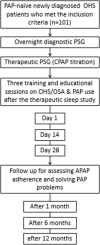Long-Term Adherence to Positive Airway Pressure Therapy in Saudi Ambulatory Patients with Obesity Hypoventilation Syndrome and Severe Obstructive Sleep Apnea: A One-Year Follow-Up Prospective Observational Study
- PMID: 33469401
- PMCID: PMC7813470
- DOI: 10.2147/NSS.S290349
Long-Term Adherence to Positive Airway Pressure Therapy in Saudi Ambulatory Patients with Obesity Hypoventilation Syndrome and Severe Obstructive Sleep Apnea: A One-Year Follow-Up Prospective Observational Study
Abstract
Purpose: Long-term studies assessing positive airway pressure (PAP) therapy adherence in patients with obesity hypoventilation (OHS) are limited. The aim of this study was to assess PAP therapy adherence in Arab (Saudi) patients with OHS and an apnea-hypopnea index (AHI) >30/h.
Methods: A prospective cohort study of consecutive adult patients diagnosed with OHS between March 2010 and September 2019 was conducted. During the therapeutic sleep study, all OHS patients were started on continuous PAP (CPAP). Patients who failed to maintain oxygen saturation ≥88% despite the elimination of obstructive respiratory events were shifted to bi-level PAP (BPAP). Objective assessment of adherence was performed at 1, 6, and 12 months after initiating PAP therapy. We adopted the American-Thoracic-Society criteria for PAP adherence.
Results: The study included 101 patients (women = 65 patients) with OHS, an AHI ≥30/h, and a mean age of 54.9 ± 12.7 years. Successful titration on CPAP was achieved in 64.4% of the patients and BPAP was required for 35.6% of the patients who failed CPAP titration. At the end of the study, 43.6% of the patients used PAP therapy in an acceptable manner. Adherence after 1 and 6 months was the only independent predictors of adherence at 12 months.
Conclusion: PAP adherence among Saudi patients with OHS and severe obstructive sleep apnea was relatively low. Almost two-thirds of patients tolerated CPAP titration with the elimination of respiratory events and desaturation. Early adherence to PAP therapy was the only predictor of PAP therapy adherence at the end of the study.
Keywords: CPAP; bi-level positive airway pressure; compliance; desaturation; obstructive sleep apnea; titration.
© 2021 Almeneessier et al.
Conflict of interest statement
The authors report no conflicts of interest for this work.
Figures
Similar articles
-
Results of CPAP Titration and Short-Term Adherence Rates in Patients with Obesity Hypoventilation Syndrome and Mild/Moderate Obstructive Sleep Apnea.Nat Sci Sleep. 2022 Jun 15;14:1137-1148. doi: 10.2147/NSS.S369316. eCollection 2022. Nat Sci Sleep. 2022. PMID: 35733818 Free PMC article.
-
Adherence Index: sleep depth and nocturnal hypoventilation predict long-term adherence with positive airway pressure therapy in severe obstructive sleep apnea.J Clin Sleep Med. 2022 Aug 1;18(8):1933-1944. doi: 10.5664/jcsm.10028. J Clin Sleep Med. 2022. PMID: 35499136 Free PMC article.
-
Clinical guidelines for the manual titration of positive airway pressure in patients with obstructive sleep apnea.J Clin Sleep Med. 2008 Apr 15;4(2):157-71. J Clin Sleep Med. 2008. PMID: 18468315 Free PMC article.
-
Noninvasive Ventilation versus CPAP as Initial Treatment of Obesity Hypoventilation Syndrome.Ann Am Thorac Soc. 2019 Oct;16(10):1295-1303. doi: 10.1513/AnnalsATS.201905-380OC. Ann Am Thorac Soc. 2019. PMID: 31365842
-
Adherence to Positive Airway Pressure Therapy in Obesity Hypoventilation Syndrome.Sleep Med Clin. 2021 Mar;16(1):43-59. doi: 10.1016/j.jsmc.2020.10.009. Epub 2020 Dec 9. Sleep Med Clin. 2021. PMID: 33485531 Review.
Cited by
-
Results of CPAP Titration and Short-Term Adherence Rates in Patients with Obesity Hypoventilation Syndrome and Mild/Moderate Obstructive Sleep Apnea.Nat Sci Sleep. 2022 Jun 15;14:1137-1148. doi: 10.2147/NSS.S369316. eCollection 2022. Nat Sci Sleep. 2022. PMID: 35733818 Free PMC article.
-
Sleep time on back as a predictor of adherence to positive airway pressure therapy.Sci Rep. 2023 Dec 16;13(1):22415. doi: 10.1038/s41598-023-49959-5. Sci Rep. 2023. PMID: 38104214 Free PMC article.
References
LinkOut - more resources
Full Text Sources
Other Literature Sources
Research Materials





